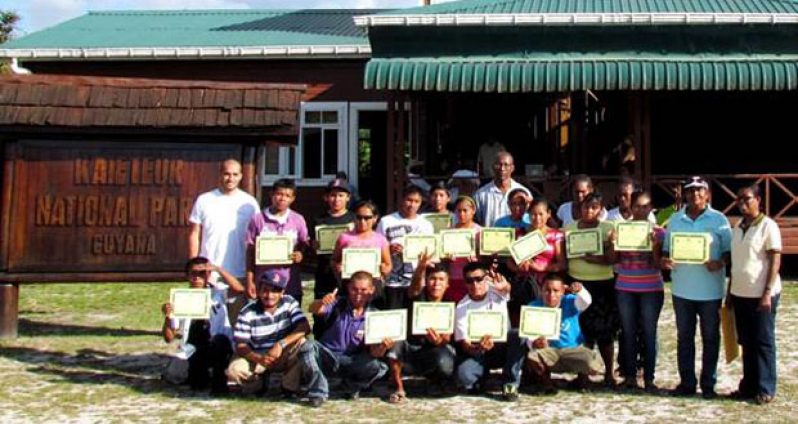THE Ministry of Natural Resources and the Environment (MNR&E) is actively supporting a collaborative approach with the community of Chenapau in Region 8 (Potaro/Siparuni) with respect to conservation within the protected area of the Kaieteur National Park (KNP).

The approach also involves strengthening community organisations and supporting livelihood activities of the community and other contiguous communities within the protected area.
The ministry disclosed that it has been working to improve the conservation and management of the KNP through the Protected Areas Commission (PAC), the Environmental Protection Agency (EPA) and the Guyana Geology and Mines Commission (GGMC).
A key part of its effort has been focused on community projects and consistent engagement with the village of Chenapau.
It said that as far back as 1999, Chenapau has had multiple representatives on the KNP Board who were part of discussions and decision-making on the development and management of the Park.
Their inclusion in the Board followed the inclusion of additional state land in the expansion of the Park to protect more of the Potaro watershed. No Titled Lands were taken away from Chenapau in this process.

Chenapau was also given the right, which it still enjoys, to use the Park for sustainable livelihoods, such as traditional hunting, fishing and gathering activities, but mining was prohibited because of the sensitive nature of the ecosystem.
The community was also a key player in the preparation of the draft KNP management plan in a process which involved multiple community meetings, which documented and verified community input and concerns.
With the recent creation of the PAC, the draft plan was taken back to the community and a two-day meeting was held with the Council and the larger community as part of the collaborative approach.
The draft plan is now being updated and finalised before again being sent back to the community for final comments. All of these engagements were well attended, as documented in the meeting reports.
The Park has also employed multiple residents of Chenapau as wardens, guesthouse attendants and other support staff. Additional employment was also facilitated in 2011 and again in 2014, when the ministry partnered with WWF to carry out biodiversity surveys in the Park and upper Potaro. During these two surveys approximately 23 and 20 residents of Chenapau were employed respectively.
In addition, the ministry and WWF conducted a week-long Tour Guide Training in October 2013, which involved 19 residents from four communities in Region 8.
Earlier this year, four trainees from among the top performers were hired as wardens at the National Park. At that point, KNP’s staff consisted of three Chenapau Residents (including the Senior Warden), two from Paramakatoi, and one from Karisparu.
Aside from direct employment, the projects also hired community boats, purchased fuel, paid for accommodation, rations and supplies, and paid village fees when landing at the Chenapau airstrip.
One of the primary projects currently being pursued with Chenapau is the purchasing of craft from the village for sale at the KNP Visitor Arrival Centre.
Discussions were held this year with members of the Council and other residents regarding a standardised process for procuring quality craft items at acceptable prices, with a sample batch already purchased.
Chenapau then requested support for a craft development project, and over $1M in additional GPAS funding was approved for Chenapau.
Under this second project, artisans from Paramakatoi and Annai were taken to the community and conducted two training courses. The first phase involved training over 30 women from Chenapau and Karisparu, while phase two led to the training of over 20 men and women in furniture- and craft-making using natural products.
Chenapau was ultimately granted one of the largest allocations of any community under the GPAS project
The ministry and its agencies remain committed to building on these partnerships with Chenapau, and working with the community to support alternative and sustainable livelihoods for its residents.
Through the EPA residents obtained assistance for the construction of an airstrip at Chenapau.
In 2009, this airstrip had been incomplete and non-functional for a number of years, and Chenapau asked the EPA for assistance to complete the airstrip.
Approximately G$20M in funding was granted to complete the airstrip, under the KfW-Guyana Protected Areas System Project.
With this funding, the airstrip was made operational, allowing villagers to directly access air transport in cases of emergency and remove the additional costs required to travel by boat to the Kaieteur Airstrip.
As a national protected area and part of our Guyanese heritage, KNP is the centre piece of Guyana’s Protected Areas System and the ministry is committed to ensuring that the Park is preserved for the sustainable use and benefit of Chenapau, the residents of Region 8 and all Guyanese.
By Clifford Stanley



.jpg)








